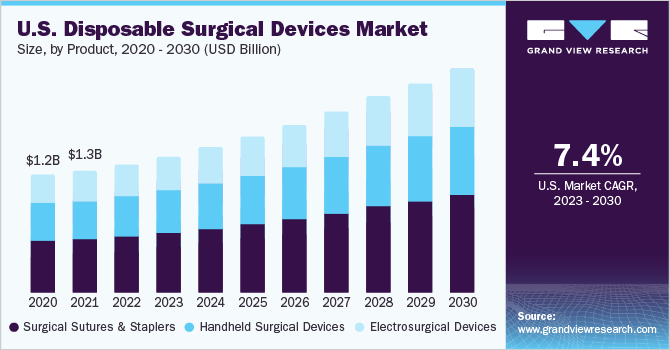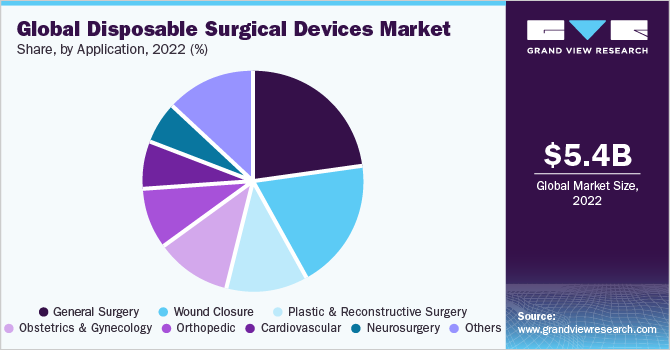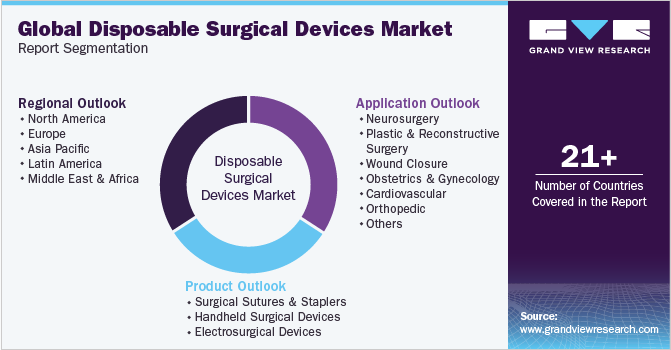- Home
- »
- Medical Devices
- »
-
Disposable Surgical Devices Market Size, Share Report 2030GVR Report cover
![Disposable Surgical Devices Market Size, Share & Trends Report]()
Disposable Surgical Devices Market Size, Share & Trends Analysis Report By Product (Surgical Sutures & Staplers, Electrosurgical devices), By Application (General Surgery, Plastic & Reconstructive Surgery), By Region, And Segment Forecasts, 2023 - 2030
- Report ID: GVR-4-68039-332-8
- Number of Report Pages: 140
- Format: PDF, Horizon Databook
- Historical Range: 2018 - 2021
- Forecast Period: 2023 - 2030
- Industry: Healthcare
Report Overview
The global disposable surgical devices market size was valued at USD 5.4 billion in 2022 and is expected to grow at a compound annual growth rate (CAGR) of 8.2% from 2023 to 2030. The increasing prevalence of chronic diseases, such as neurological, cardiovascular, infectious, and urological disorders, is expected to boost the market's growth. The high incidence of diseases, such as diabetes, cancer, and other autoimmune disorders across the globe is also a major factor responsible for the rising number of surgical procedures. As per the International Diabetes Federation (IDF), around 530 million people worldwide had diabetes in 2021, and this number is expected to reach 643 million by 2030. Type II diabetes is the most common type and 90% of the diabetic population is suffering from this form of the disease.

The increasing number of surgical procedures is also one of the key factors expected to drive the overall market. In January 2023, the International Society of Aesthetic Plastic Surgery (ISAPS) released its annual report, projecting a 19.3% increase in 2021 plastic surgery procedures, with over 12.8 million surgical and 17.5 million non-surgical procedures performed globally. These facts highlight that there will be a steady demand for plastic surgeries in the coming years. As a result, the usage of disposable surgical devices is anticipated to grow over the forecast period.
Sterilization plays an important role in the healthcare industry. The probability of getting affected by an infection or a virus is high in medical settings like clinics, hospitals, and laboratories. Using disposable medical devices helps overcome the challenges of sterilizing a device used for a procedure. Patients must visit medical settings such as hospitals for surgical procedures. Moreover, COVID-19 had negatively impacted patients' visits to these medical settings, hindering the adoption of surgical procedures. However, the number of surgical procedures is expected to increase gradually over the forecast period. During the pandemic, a large population preferred disposable devices for usage and treatment to avoid transmitting the virus. Therefore, the growing health consciousness, increasing number of hospital visits, and longer hospital stays are expected to boost the market's growth during the forecast period.
Despite various advantages associated with disposable devices and the growing demand for these devices, certain factors may limit the market growth. Surgical sutures and staplers are mainly used for wound closure surgeries. However, these devices cause pain and require frequent hospital or clinic visits for removal. In addition, these devices sometimes lead to infections and tissue inflammation, negatively impacting their adoption. To avoid infection and pain, people seeking wound closure surgeries mostly prefer less or non-invasive options, such as glues and sealants. The availability of less or non-invasive alternatives for disposable surgical devices can hinder market growth during the forecast period.
Product Insights
The market is segmented into surgical sutures, handheld, and electrosurgical devices based on product. Surgical sutures and staplers held the largest share of 45.0% in 2022. Surgical sutures are threads used after surgery or in treating an injury to close incisions or repair cuts. Surgical staplers are also used for wound closure and are more precise than sutures. The process of surgical stapling is quicker.
Moreover, staples lead to a lower risk of infection than sutures. Sutures are the conventional way of closing a wound; however, the risk of a wound reopening with sutures is comparatively lower than with staples. The growing development of disposable sutures and staplers by various market players is also expected to contribute to the segment growth. For instance, In June 2022, Ethicon, Inc., a subsidiary of Johnson & Johnson, launched the ECHELON 3000 Stapler in the US, offering digitally enabled articulation for surgeons. With a 39% greater jaw aperture and 27% greater articulation span, it provides better control and real-time audible feedback for critical adjustments during procedures.
Electrosurgical devices are expected to grow at the fastest rate of 9.0% over the forecast period. Electrosurgical instruments help perform surgeries in ambulatory surgical centers (ASCs) or clinics without the need for hospital settings. Outpatient settings usually include short-period surgery, resulting in the reduction of surgery costs. Among all the surgical instruments, electrosurgical products are witnessing significant growth. Bipolar electrosurgical instruments have emerged as significantly useful in minimally invasive endoscopic surgeries, propelling segment growth. In June 2023, Olympus Corporation released its latest electrosurgical generator, the ESG-410, for treating bladder cancer and enlarged prostate. This device offers efficient treatment options for resection loops, band electrodes, and vaporization buttons and needles.
Application Insights
Based on application, the market is segmented into neurosurgery, wound closure, obstetrics & gynecology, cardiovascular, plastic & reconstructive surgery, orthopedic, general surgery, and others. General surgery held the largest share of 23.3% in 2022. The growth of this segment is driven by the increasing prevalence of chronic diseases like cancer, diabetes, and cardiovascular disorders, which demand surgical interventions. The demand for minimally invasive procedures reduces infection and complications, driving the adoption of disposable surgical devices in general surgery.
The plastic and reconstructive surgery segment is expected to grow at the fastest rate of 9.0% over the forecast period. According to the American Society of Plastic Surgeons, in 2020, 2.3 million cosmetic surgical procedures and 13.2 million cosmetic minimally-invasive procedures were performed in the U.S. Most minimally-invasive surgeries involve the use of disposable surgical instruments, thereby expected to propel the market growth.

The obstetrics and gynecology segment is expected to grow significantly during the forecast period. Obstetrics specifically includes pregnancy and childbirth, whereas gynecology is a broader aspect, including all female reproductive organ disorders. Common surgical procedures involving female reproductive organs include episiotomy and cervical cerclage. In addition, minimally invasive gynecologic surgeries lead to less postoperative pain, resulting in shorter hospital stays. These surgeries involve surgical tools, such as laparoscopes and hysteroscopy. The growing development of disposable surgical devices for obstetrics and gynecology to avoid infection transmission is expected to contribute to the segment's growth.
Regional Insights
North America held the largest share of 29.7% in 2022. This can be attributed to the increasing incidence of chronic diseases, such as cardiovascular and neurological diseases, cancer, diabetes, and autoimmune diseases. In addition, an increase in the number of surgical procedures due to accidents, burns, and trauma cases is one of the major factors driving the surgical instruments market in the region.

According to the WHO, the burden of non-communicable diseases (NCDs) is the highest in the European region and is expected to grow at a high rate in the near future. As per the WHO, chronic diseases such as diabetes, cardiovascular disorders, chronic respiratory diseases, mental disorders, and cancer contributed to an estimated 86% of deaths in the region, contributing to 77% of the disease burden in the European region. Unhealthy dietary habits, sedentary lifestyles, smoking, and alcohol consumption are the primary reasons for the increased disease burden in Europe. Surgical interventions help treat and manage these diseases, facilitating the use of disposable surgical tools. With a substantial increase in the number of surgeries being performed due to a rise in the incidence of chronic diseases, the demand for these instruments is increasing.
Middle East and Africa is expected to grow at the fastest rate of 9.0% during the forecast period. The high prevalence of cardiovascular, orthopedic, and other infections; increasing incidence of these conditions; and rising expenditure on the prevention and diagnosis of infectious diseases are likely to be the key factors responsible for the growth of this market.
The Asia Pacific segment is expected to grow significantly during the forecast period. A large patient pool in the region is expected to contribute to the regional market growth. Japan has a large geriatric population that requires increased care and attention regarding health. According to the Japan Cancer Society (JCS), one in three deaths in Japan occurred due to cancer, with lung and stomach cancers being the most frequent types. With an increase in the prevalence of such cancers, preventive surgeries are often performed to limit the growth of malignant tumors in the body. Therefore, the growing number of surgeries is expected to increase the need for disposable surgical devices.
Competitive Insights
Key market players hold a significant market share due to their broad product portfolio. They are forming strategic alliances to expand their product portfolio. For instance, in October 2022, Aspen Surgical Products acquired Symmetry Surgical from RoundTable Healthcare Partners, a leader in disposable surgical products, as part of Audax Private Equity's portfolio. Similarly, in November 2020, Aspen Surgical acquired Protek Medical Products, Inc. These acquisitions will help Aspen strengthen its product portfolio, including disposable surgical devices.
In June 2023, IceCure Medical Ltd., a Chinese developer of minimally invasive cryoablation technology, received approval from the National Medical Products Administration (NMPA) to commercialize its IceSense3 disposable cryoprobes. The ProSense System, marketed under the IceSense3 brand, uses freezing to destroy tumors as an alternative to surgical removal. The following are some of the major participants in the global disposable surgical devices market:
-
B. Braun SE
-
Smith+Nephew
-
Aspen Surgical
-
Alcon Laboratories, Inc.
-
Zimmer Biomet.
-
Medtronic
-
BD
-
Ethicon
-
CooperSurgical Inc.
-
Surgical Innovations
Disposable surgical devices market Report Scope
Report Attribute
Details
Market size value in 2023
USD 5.8 billion
Revenue forecast in 2030
USD 10.1 billion
Growth Rate
CAGR of 8.2% from 2023 to 2030
Base year for estimation
2022
Historical data
2018 - 2021
Forecast period
2023 - 2030
Quantitative units
Revenue in USD million/billion and CAGR from 2023 to 2030
Report coverage
Revenue forecast, company ranking, competitive landscape, growth factors, and trends
Segments covered
Product, application, region
Regional scope
North America; Europe; Asia Pacific; Latin America; MEA
Country scope
U.S.; Canada; UK Germany; France; Italy; Spain; Denmark; Sweden; Norway; Japan; China; India; Australia; South Korea; Thailand; Brazil; Mexico; Argentina; South Africa; Saudi Arabia; UAE; Kuwait
Key companies profiled
B. Braun SE; Smith+Nephew; Zimmer Biomet; Alcon Laboratories, Inc.; Aspen Surgical; Medtronic; BD; Ethicon; CooperSurgical Inc.; Surgical Innovations
Customization scope
Free report customization (equivalent up to 8 analyst’s working days) with purchase. Addition or alteration to country, regional & segment scope
Pricing and purchase options
Avail customized purchase options to meet your exact research needs. Explore purchase options
Global Disposable Surgical Devices Market Report Segmentation
This report forecasts revenue growth at the global, regional, and country levels and provides an analysis of the latest industry trends and opportunities in each of the sub-segments from 2018 to 2030. For this study, Grand View Research has segmented the global disposable surgical devices market report on the basis of product, application, and region:

-
Product Outlook (Revenue, USD Million, 2018 - 2030)
-
Surgical sutures & staplers
-
Handheld surgical devices
-
Electrosurgical devices
-
-
Application Outlook (Revenue, USD Million, 2018 - 2030)
-
Neurosurgery
-
Plastic & reconstructive surgery
-
Wound closure
-
Obstetrics & gynecology
-
Cardiovascular
-
Orthopedic
-
General surgery
-
Others
-
-
Regional Outlook (Revenue in USD Million, 2018 - 2030)
-
North America
-
U.S.
-
Canada
-
-
Europe
-
UK
-
Germany
-
France
-
Italy
-
Spain
-
Denmark
-
Sweden
-
Norway
-
-
Asia Pacific
-
Japan
-
China
-
India
-
Australia
-
Thailand
-
South Korea
-
-
Latin America
-
Brazil
-
Mexico
-
Argentina
-
-
Middle East and Africa
-
South Africa
-
Saudi Arabia
-
UAE
-
Kuwait
-
-
Frequently Asked Questions About This Report
b. The global surgical disposable devices market size was estimated at USD 5.4 billion in 2022 and is expected to reach USD 5.8 billion in 2023.
b. The global disposable surgical devices market is expected to grow at a compound annual growth rate of 8.2% from 2023 to 2030 to reach USD 10.1 billion by 2030.
b. North America dominated the disposable surgical devices market with a share of 29.7% in 2022. This is attributable to an increase in the number of surgical procedures due to accidents, burns, and trauma cases in the region.
b. Some key players operating in the disposable surgical devices market include B. Braun Melsungen AG, Smith & Nephew plc, Aspen Surgical, Zimmer Biomet, Medtronic, Becton, Dickinson and Company, Ethicon, CooperSurgical Inc., Surgical Innovations, and Alcon Laboratories, Inc.
b. Key factors that are driving the disposable surgical devices market growth include the increasing prevalence of chronic diseases, rising number of road accidents, and rise in the number of surgical procedures.
Share this report with your colleague or friend.
![gvr icn]()
NEED A CUSTOM REPORT?
We can customize every report - free of charge - including purchasing stand-alone sections or country-level reports, as well as offer affordable discounts for start-ups & universities. Contact us now
![Certified Icon]()
We are GDPR and CCPA compliant! Your transaction & personal information is safe and secure. For more details, please read our privacy policy.
We are committed towards customer satisfaction, and quality service.
"The quality of research they have done for us has been excellent."





